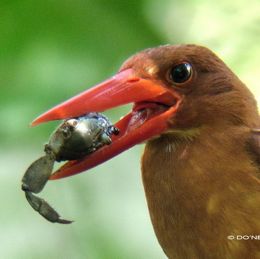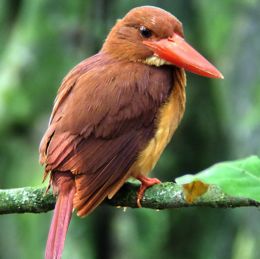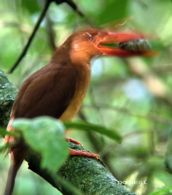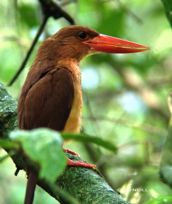By tradition, kingfishers are placed in a huge single family, pronged by three sub-families belonging to the Halcyonidae (Wood Kingfishers), Alcedinidae (Small Kingfishers) and Cerylidae (Pied & Green Kingfishers). Let’s take a look at one of the Wood Kingfishers- Ruddy Kingfisher (Halcyon coromanda) found perched in stoic pose with a large crab wedged in by a dagger like, oversized red beak in a forested mangrove river edge (below left).
Let’s hide behind a tree trunk and observe through a 82mm diameter digiscope, observe how this colourful, feathered, plump bodied bird coped with such a huge catch; at close range, admire its dark, brown eyes stud in an oversized head and short, bright red legs gripping a horizontal branch with its 3 joined, forwarded toes for counter balance.
Ruddy Kingfishers are strongly territorial and their diet is known to consist of worms, insects, small lizards including crustacean, small mammals and even young birds.
Admire too, Ruddy’s plumage of rufous undercarriage, overshadowed by violet-magenta uppers setting this species contrastingly apart from other species. In flight, it coyly flashes a light blue feathered rump like a marathon lighted torch on a flying sprinter, chasing after its own repeated loud, staccato, shrill noted calls of the bird (above right).
This extremely shy bird sensed my presence and refused to concede to relish the crustacean. And so, a waiting game began where it continued to perch motionless with crab in beak.
I remained hunched over my digiscope and waited for some action from the bird.
As time ticked by, my head began screaming to levitate away from my neck that died stiff of the waiting game. I surrendered.
Ruddy finally relented when thought I wasn’t looking and began the process of dismembering the remaining foot of the equally screaming crustacean.
‘Ouch!! ..do you mind? What do you think you are dooooing?
Ruddy playing selective deafness, repeatedly whacked the crab on the tree branch, leaving a tenderized body and a pair of black unforgiving eyes star-gazing into the menacing eyeballs of Ruddy that repeatedly said, “I gonna eat ya!, I gonna eat ya!”
This was followed by vigorous tossing and repositioning of the crab in its beak for best swallowing position before Ruddy Kingfisher took the crustacean whole, chased down by one mighty gulp into the bird’s belly. Attach blurry action images too fast for my camera to handle and shows Ruddy’s bulging belly (above).
Ruddy was seen on earlier visits with a mate. Otherwise, sighting of this quality species would be uncommon and when encountered, would usually be seen quietly perched and alone.
It was my first encounter with a raucous, breeding pair that appeared to be thoroughly enjoying the freedom of romance play-flying, ‘catch me if you can’ through the mangrove forested river edge.
Join me next in the red-iron bird to venture beyond shores, see through Avian Writer’s eyes, be transported in spirit, be entertained and be fascinated by other unusual species of endemic Kingfishers and the wild.
Let’s do that…. before they all disappear in the wilderness of concrete jungles.
AVIAN WRITER DAISY O’NEILL PENANG MALAYSIA
© Ruddy Kingfisher Eats One-legged Crab














4 Responses
Hai, i just caught one of this beautiful species which got into our laundry room… But i manage to take some picture of it, and rest assure theres no cruelty involve, as I’m an animal lover myself… 🙂 Just want to know whether this species is very endangered? and to what extend people take this bird as pets?
Btw, i’ve release this gorgeous bird and for the reason it might wake up the neighbour with its loud cry… 🙂 but still a gorgeous bird to have caught and save… i think it was abit disorientated because when i caught it it look wobbly and all… when we release it, it did fly away but with a bit of problem navigating itself around… wish i could do more to help it, but it manage to fly away safely…
The Ruddy Kingfisher is an uncommon resident as well as an uncommon winter visitor and passage migrant in Singapore and Malaysia. It is not globally threatened.
Why not send your images and story to [email protected] and we will post it in the blog. It should be an interesting story.
In reply to Kelvin Henry, as an aviculturalist for many years, all the literature I have read on the subject strongly recommends against trying to keep kingfishers as pets.
Responsible aviculture is not about keeping birds simply for their plumage or confining them in small cages just for their song. It is about making serious attempts to study birds and breed them in captivity to ensure that a gene pool will survive if the natural population is wiped out.
Unfortunately, not all genera of birds take well to captive breeding, and serious aviculturalists should avoid those in which the known problems are difficult to surmount.
In the case of kingfishers, they require large (very large) accommodation and a constant source of small live food (not necessarily fish). Many do not recognise non-moving prey items as food. The only member of the family that does well in captivity is the Kookaburra, which is a general carnivore and dines readily on steak and poultry.